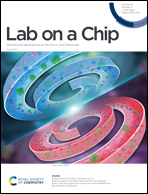Fluid shear stress in a logarithmic microfluidic device enhances cancer cell stemness marker expression†
Abstract
Fluid shear stress (FSS) is crucial in cancer cell survival and tumor development. Noteworthily, cancer cells are exposed to several degrees of FSS in the tumor microenvironment and during metastasis. Consequently, the stemness marker expression in cancer cells changes with the FSS signal, although it is unclear how it varies with different magnitudes and during metastasis. The current work explores the stemness and drug resistance characteristics of the cervical cancer cell line HeLa in a microfluidic device with a wide range of physiological FSS. Hence, the microfluidic device was designed to achieve a logarithmic flow distribution in four culture chambers, realizing four orders of biological shear stress on a single chip. The cell cycle analysis demonstrated altered cell proliferation and mitotic arrest after FSS treatment. In addition, EdU staining revealed increased cell proliferation with medium to low FSS, whereas high shear had a suppressing effect. FSS increased competence to withstand higher intracellular ROS and mitochondrial membrane potential in HeLa. Furthermore, stemness-related gene (Sox2, N-cadherin) and cell surface marker (CD44, CD33, CD117) expressions were enhanced by FSS mechanotransduction in a magnitude-dependent manner. In summary, these stemness-like properties were concurrent with the drug resistance capability of HeLa towards doxorubicin. Overall, our microfluidic device elucidates cancer cell survival and drug resistance mechanisms during metastasis and in cancer relapse patients.



 Please wait while we load your content...
Please wait while we load your content...